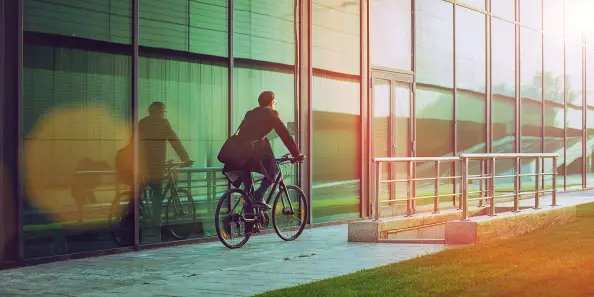5 Tips for Sustainable Event Planning
Environmentally friendly events are important to us. But how does sustainable event planning work? We have compiled five tips for you to support you on your way to climate-neutral meetings, conferen...
The ‘hybrid’ or ‘digital’ event is the order of the day. STATION-Berlin and Neumann&Müller event technology services join us to discuss successful digital event formats.
The monitor flickers. In our digital space, we welcome Janina Meyer and Jennifer Mahneke from event location STATION-Berlin event location as well as Benjamin Bessey representing the Neumann&Müller technical event services. During Germany’s second corona virus lockdown, such a virtual meeting is the new normal. But could events with several hundred or thousands of attendees ‘simply’ be transferred online? How can a digital format convey an event location’s character? What should digital events cost? And how can hybrid and digital formats be professionally presented? In our conversation, these three experts share their expertise and experience.
“Fortunately, we know how it works,“ says Benjamin Bessey, who has been with Neumann&Müller high end technology service provider for a number of years. Even before Covid-19, events were already being streamed. But streaming was never the centre of interest – as Janina Meyer confirms: “Virtual options have been around for a long time, though only for particular target groups.” One example is re:publica, she notes, which has always had a digital presence to give a broad audience low-threshold access to the content. In contrast, things look different in large traditional companies using classic event formats where, as she says, “The event design does not even include digital elements.”
STATION Berlin is a multifunctional event location and has a permanently installed but variable streaming studio.
Ready to play for online, hybrid & live events.
Equipped to the latest technical standards, Hall 3 with 4,200 m² of event space has pre-installed technical equipment, camera/lighting technology, green screen, two stages and can be customized according to the customer's wishes.
As the experts point out, existing customers as well as new target groups need to be addressed before classic formats can move into the virtual world as well. This is a great opportunity for us, for example, for press conferences or workshops. But many customers are still not familiar with the potential of digital options. “Our most important task is to reassure our customers,” Meyer says. They have a range of concerns – ‘Can I really do the same digitally?’; ‘What do I need for it to work?’; ‘Can I still plan to have guests on site at a hybrid event?’; ‘Is the format secure?’
STATION-Berlin has designed packages for various options. “This allows customers to decide how much support they need,” explains Jennifer Mahneke. “Importantly, we can still respond flexibly to meet individual requirements.” In essence, for customers to go digital – and here all our experts agree – a robust communications process is crucial to ensure the possibilities and exact requirements are perfectly aligned. And this is vital precisely people are not meeting in person in real life.
Hybrid formats are complex – and that complexity, Bessey explains, comes from the need for professional live content as well as digital content for virtual attendees. To ensure hybrid events are dynamically designed, he recommends a continuity director. Another important fundamental is an attractive screen image for digital attendees, and that requires professional camera work with several cameras. And to make 100% sure everything matches the customer’s vision, a rehearsal is also well worthwhile. “For digital formats, you can’t just quickly book another loudspeaker or spotlight,” Bessey points out. “On virtual platforms, you always need to run checks or work with a special digital programme.” Moreover, many people have no prior experience of being on camera – something that also requires practice.

Data security is also a key concern. And for secure data everyone need in-depth communication in the run-up phase and to be familiar with the format. According to Bessey, data connections are most secure when they run over wired networks and not over wireless networks such as WLAN, as the latter are more vulnerable to hacker attacks. "For live streams, we exclusively use our own server infrastructure in Germany in the so-called Content Delivery Network CDN. This means that all streams are in accordance with the General Data Protection Regulation (GDPR)." This also prevents personal data in the form of cookies from being used by outside companies, he said. But when everything is working smoothly, digital and hybrid events can be staged with up to 40,000 attendees.
Many think that digital events make location searches superfluous. After all, if everything is digital, why look for that special location? But Mahneke and Meyer are only too aware of how a location’s diversity can also be leveraged and transported online. Parallel activities can be held in various spaces, contributing to an event’s storytelling. Bessey strongly recommends avoiding recording in a warehouse hung with black fabric. As he knows from experience, “The impression of a location makes every digital event more interesting.” In addition, as Mahneke notes, there’s also the issue of safety in the corona pandemic: “We offer rapid corona testing for guests attending in person on-site and support the organisers by providing hygiene schedules.” In a digital space too, professional location planning is important – from social distanced seating to stage design and technology – to present the content professionally and convey the feeling of the experience.

Whether virtual or live – professional planning and implementation is a must. Digital formats are just as complex as virtual ones. One example here is the exchange between participants – at a hybrid event, this exchange takes place through the interface between on-site and digital attendees. “And that is far more involved than a coffee break at a live event,” Bessey points out.
“Many customers still lack an appreciation of how costs are incurred even without on-site guests,“ says Meyer, adding a concrete example. “At STATION-Berlin live events before social distancing, we could have 8.000 people in an area measuring 2.000 square metres. Now, that space takes a maximum of 200 people.” Theoretically, though, the price would still be the same – something customers find hard to understand.
One other factor is data security: “If the data is to be kept at the event, that service also costs money,” Bessey comments. Here, the duration of streaming and the number of participants as well as back-up systems and additional internet connections away from the internal connection drive up the costs. On the other hand, organisers end up with a much higher reach and can generate more turnover.
Here, everyone is agreed on the answer – a resounding no!
Virtual events cannot be a substitute for meeting people in person. “People want to have those real-life encounters just as much as ever,” Mahneke says. “Even before the Covid-19 pandemic, there were hybrid formats with big advantages for an event’s reach. But that feeling of getting together in real live can’t be reproduced virtually.” For these sector experts, mixing both formats – live and digital – would be the answer in future. This would also pay off when it comes to sustainability. After all, as Bessy points out, given the high-performance servers needed for HD quality video streaming, holding solely digital events would also have a negative impact on the environment.
Digital encounters cannot and will not replace real meetings, but only complement them - sustainably.
You can find more streaming and hybrid studios in our Meeting Guide Berlin.
You haven't found what you are looking for yet? Then write to us at convention@visitBerlin.de. We are looking forward to your request!

Environmentally friendly events are important to us. But how does sustainable event planning work? We have compiled five tips for you to support you on your way to climate-neutral meetings, conferen...

Wie gehen wir in der MICE-Branche mit Themen wie Klimawandel, endlichen Ressourcen, Fachkräftemangel und der stetig steigenden Kundennachfrage nach nachhaltigen Angeboten um? Unsere Antwort ist Sust...